Human-Induced Forest Fragmentation in Trabzon, Eastern Black Sea Region, Türkiye: A Case Study
Abstract
1. Introduction
2. Materials and Methods
3. Results
3.1. Forest Fragmentation and Spatial Land Metrics
3.2. Status of Forests Fragmentation
3.3. Management Plan Data of Fragmented Forests and Implementation Results
3.3.1. EBM Map
3.3.2. Forest Functions and Management Purpose Map
4. Discussion and Conclusions
Funding
Data Availability Statement
Acknowledgments
Conflicts of Interest
References
- Anonymous. The Report of Sustainable Forest Management; General Directore of Forestry: Ankara, Türkiye, 2008.
- Anonymous. Forest Policy Note Turkey. Financing and Global Knowledge: Bringing the Best to Turkey and Sharing the Best of Turkey with the Word, Word Bank Group. 2017. Available online: http://documents.worldbank.org/curated/en/694751507885204989/pdf/12-10-2017-13-48-33-TurkeyForestPolicyNoteweb.pdf (accessed on 20 July 2022).
- Seven, Y. 2009. Soy K&G, General Directore of Forestry. Available online: http//www.ogm.gov.tr/ekutuphane/.../Sunular/ANTALYA%20YUNUS%20SEVEN.pptx (accessed on 9 April 2022).
- Deniz, B.; Küçükerbaş, E.V.; Eşbah Tunçay, H. General Introduction to Landscape Ecology. Adnan Menderes Univ. Fac. Agric. J. Agric. Sci. 2006, 3, 5–18. [Google Scholar]
- Goparaju, L.N. Save Forests: Avoid Forest Fragmentation. 2011. Available online: https://thinktosustain.com/2011/06/save-forests-avoid-forest-fragmentation/ (accessed on 25 May 2023).
- Coşkun Hepcan, Ç. Identification and Planning of Ecological Networks as a Sustainabile Approach in Nature Conservation; the Case of Çeşme-Urla Peninsula. Ph.D. Thesis, Institute of Science, Ege University, İzmir, Türkiye, 2008. Available online: https://tez.yok.gov.tr/UlusalTezMerkezi/tezDetay.jsp?id=uTNkvayJJQZBTQGPFML-hw&no=vPHj-akrEWS8eoQx3xGpvQ (accessed on 10 September 2022).
- Synder, M. What Is Forest Fragmentation and Why Is It a Problem? 2014. Available online: https://northernwoodlands.org/articles/article/forest-fragmentation (accessed on 10 June 2023).
- Williams, J.C.; Snyder, S.A. Restoring habitat corridors in fragmented landscapes using optimization and percolation models. Environ. Model. Assess. 2005, 10, 239–250. [Google Scholar] [CrossRef]
- Anonymous. The European Environment, State and Outlook 2015. European Briefings, Forests, European Environment Agency. 2015. Available online: https://www.eea.europa.eu/downloads/5e8077f693a943eaaf614f296ab92a94/1479205837/forests.pdf (accessed on 10 September 2022).
- Abdullah, S.A.; Nakagoshi, N. Forest fragmentation and its correlation to human land use change in the state of Selangor, peninsular Malaysia. For. Ecol. Manag. 2007, 241, 39–48. [Google Scholar] [CrossRef]
- Anonymous. 2015-23. Trabzon Provincial Plan 2015–2023; Republic of Türkiye Governorship of Trabzon: Trabzon, Türkiye, 2015.
- Anonymous. State Forest Enterprise of Trabzon Activity Report 2018; Ministry of Agriculture and Forestry, General Directorate of Forestry, State Forest Enterprise of Trabzon: Trabzon, Türkiye, 2018.
- Teh, M.Z.; Ghani, I.; Abdullah, M. Development of Landscape Structure Index as Basis Indicator for Landscape Quality and Character: A Review. International Conference on Livable Cities. Int. Con. on Livable Cities, University Sains Malaysia, Penang, 2015. Available online: https://www.academia.edu/19526954/DEVELOPMENT_OF_LANDSCAPE_STRUCTURE_INDEX_AS_BASIS_INDICATOR_FOR_LANDSCAPE_QUALITY_AND_CHARACTER_A_REVIEW (accessed on 12 June 2022).
- McGarigal, K.; Marks, B.J. FRAGSTATS: Spatial Pattern Analysis Program for Quantifying Landscape Structure. USDA Forest Service General Technical Report PNW-351, Corvallis. 1995. Available online: https://www.fs.usda.gov/pnw/pubs/pnw_gtr351.pdf (accessed on 25 June 2022).
- Şentürk, Ö. Determination of The Changes Occurred in the Last Forty Years in the Spatial Structure of Brutian Pine Forests Located in Aşağıgökdere Forest District in Eğirdir-Isparta. Master’s Thesis, Institute of Science, Süleyman Demirel University, Isparta, Türkiye, 2008. Available online: https://acikbilim.yok.gov.tr/bitstream/handle/20.500.12812/286814/yokAcikBilim_328480.pdf?sequence=-1&isAllowed=y (accessed on 6 February 2022).
- Alphan, H. Analysis of landscape changes as an indicator for environmental monitoring. Environ. Monit. Assess. 2016, 189, 24. [Google Scholar] [CrossRef]
- Zhang, L.; Liu, Y.; Wei, X. Forest Fragmentation and Driving Forces in Yingkou, Northeastern China. Sustainability 2017, 9, 374. [Google Scholar] [CrossRef]
- Wyman, M.S.; Stein, T.V. Modeling social and land-use/land-cover change data to assess drivers of smallholder deforestation in Belize. Appl. Geogr. 2010, 30, 329–342. [Google Scholar] [CrossRef]
- Bulut, N.D.; Gümüş, C.; Er, U.; Sayin, M.A.; Gerçek, V.; Ayaz, H.; Çolak, N. Evaluation of management problems of fragmented forests: A case study on Trabzon Forest District Directorate. Turk. J. For. Res. 2019, 6, 177–191. [Google Scholar] [CrossRef]
- İnal, S. Forestry and forestry issues in Türkiye. Orman Ve Av 1957, 1, 12–20. [Google Scholar]
- İlkmen, Ş.N. The Problem of Statism in Forest Management and the Main Cases of Our Forestry Policy. In Panel of Scientific Opinions on Various Aspects of Our Forest Case; Turkey Foresters Association: Ankara, Türkiye, 1951; pp. 11–28. [Google Scholar]
- Gümüş, C. A historical review on the effects of settlement problems on Turkish Forestry. In Proceedings of the International New Horizons in Forestry, Isparta, Türkiye, 18–20 October 2017; University of Süleyman Demirel: Isparta, Türkiye, 2017; p. 70. [Google Scholar]
- Sari, B.; Karahalil, U. Land cover dynamics in Akçaabat planning unit between 1984 and 2008. In Proceedings of the 1st International Conference on Sea and Coastal Development in the Frame of Sustainability, Trabzon, Türkiye, 18–20 September 2015; Karadeniz Technical University: Trabzon, Türkiye, 2015; pp. 750–758. [Google Scholar]
- Zengin, H.; Değermenci, A.S.; Bettinger, P. Analysis of temporal changes in land cover and landscape metrics of a managed forest in the west Black Sea region of northern Turkey: 1970–2010. J. For. Res. 2017, 29, 139–150. [Google Scholar] [CrossRef]
- Lim, J.N.W.; Douglas, I. Land management policy and practice in a steepland agricultural area: A Malaysian ex-ample. Land Degrad. Dev. 2000, 11, 51–61. [Google Scholar] [CrossRef]
- Girvetz, E.H.; Thorne, J.H.; Berry, A.M.; Jaeger, J.A. Integration of landscape fragmentation analysis into regional planning: A statewide multi-scale case study from California, USA. Landsc. Urban Plan. 2008, 86, 205–218. [Google Scholar] [CrossRef]
- Butler, B.J.; Swenson, J.J.; Alig, R.J. Forest fragmentation in the Pacific Northwest: Quantification and correlations. For. Ecol. Manag. 2004, 189, 363–373. [Google Scholar] [CrossRef]
- Tağıl, Ş. Change of habitat fragmentation and quality in the Balikesir plain and its surroundings with landscape pattern metrics (1975–2000). Ekoloji 2006, 15, 24–36. [Google Scholar]
- Jain, P.; Ahmed, R.; Sajjad, H. Assessing and monitoring forest health using a forest fragmentation approach in Sariska Tiger Reserve, India. Nor. Geogr. Tidsskr. Nor. J. Geogr. 2016, 70, 306–315. [Google Scholar] [CrossRef]
- Lepers, E.; Lambin, E.F.; Janetos, A.C.; DeFries, R.S.; Achard, F.; Ramankutty, N.; Scholes, R.J. A Synthesis of Information on Rapid Land-cover Change for the Period 1981–2000. BioScience 2005, 55, 115–124. [Google Scholar] [CrossRef]
- Geist, H.J.; Lambin, E.F. Proximate Causes and Underlying Driving Forces of Tropical Deforestation: Tropical forests are disappearing as the result of many pressures, both local and regional, acting in various combinations in different geographical locations. Bioscience 2002, 52, 143–150. [Google Scholar] [CrossRef]
- McConnell, W.J.; Sweeney, S.P.; Mulley, B. Physical and social access to land: Spatio-temporal patterns of agricultural expansion in Madagascar. Agric. Ecosyst. Environ. 2004, 101, 171–184. [Google Scholar] [CrossRef]
- Karahalil, U.; Çil, B.; Toylan, Y. The expansion of settlement and agriculture areas towards to coastal zone and high lands between 1970 and 2009 in Yomra district. In Proceedings of the 1st International Conference on Sea and Coastal Development in the Frame of Sustainability, Trabzon, Türkiye, 18–20 September 2015; Karadeniz Technical University: Trabzon, Türkiye, 2015; pp. 731–741. [Google Scholar]
- Liu, S.; Dong, Y.; Deng, L.; Liu, Q.; Zhao, H.; Dong, S. Forest fragmentation and landscape connectivity change associated with road network extension and city expansion: A case study in the Lancang River Valley. Ecol. Indic. 2013, 36, 160–168. [Google Scholar] [CrossRef]
- Dewan, A.M.; Yamaguchi, Y.; Rahman, Z. Dynamics of land use/cover changes and the analysis of landscape fragmentation in Dhaka Metropolitan, Bangladesh. GeoJournal 2010, 77, 315–330. [Google Scholar] [CrossRef]
- Saatçioğlu, F. The Struggle between Agriculture and Forestry in Our Country and the Necessity of Iinternal Settlement. In Panel of Scientific Opinions on Various Aspects of Our Forest Case; Turkey Foresters Association: Ankara, Türkiye, 1951; pp. 34–45. [Google Scholar]
- Irmak, A. We should make rational use of forest and agricultural lands. In Panel of Scientific Opinions on Various Aspects of Our Forest Case; Turkey Foresters Association: Ankara, Türkiye, 1951; pp. 46–48. [Google Scholar]
- Liu, J.; Coomes, D.A.; Gibson, L.; Hu, G.; Liu, J.; Luo, Y.; Wu, C.; Yu, M. Forest fragmentation in China and its effect on biodiversity. Biol. Rev. 2019, 94, 1636–1657. [Google Scholar] [CrossRef]
- Newmark, W.D. Forest Area, Fragmentation, and Loss in the Eastern Arc Mountains: Implications for the Conservation of Biological Diversity. J. East Afr. Nat. Hist. 1998, 87, 29–36. [Google Scholar] [CrossRef]
- Bogaert, J.; Barima, Y.S.S.; Iyongo, L.; Mongo, W.; Bamba, I.; Mama, A.; Toyi, M.; Lafortezza, R. Forest Fragmentation: Causes, Ecological Impacts and Implications for Landscape Management. In Landscape Ecology in Forest Management and Conservation, Challenges and Solutions for Global Change; Li, C., Lafortezza, R., Chen, J., Eds.; Springer: Berlin/Heidelberg, Germany, 2011; pp. 273–296. ISBN 978-3-642-12753-3. [Google Scholar]
- Bayramoğlu, M.M.; Kadıoğulları, A. Analysis of Land Use Change and Forestation in Response to Demographic Movement and Reduction of Forest Crime. Eurasia J. Math. Sci. Technol. Educ. 2017, 14, 225–238. [Google Scholar] [CrossRef] [PubMed]
- Sen, G.; Bayramoglu, M.M.; Toksoy, D. Spatiotemporal changes of land use patterns in high mountain areas of Northeast Turkey: A case study in Maçka. Environ. Monit. Assess. 2015, 187, 1–14. [Google Scholar] [CrossRef] [PubMed]
- Çakir, G.; Sivrikaya, F.; Keleş, S. Forest cover change and fragmentation using Landsat data in Maçka State Forest Enterprise in Turkey. Environ. Monit. Assess. 2007, 137, 51–66. [Google Scholar] [CrossRef]
- Çakır, G.; Güler, A.; Zengin, H.; Değermenci, A.S. Integration of cadaster information with forest management and planning. Düzce Univ. J. For. 2014, 10, 48–58. [Google Scholar]
- Çakır, G. Determination of Temporal Changes in Forest Resources of Istanbul Province with Remote Sensing and GBS. Master’s Thesis, Institute of Science, Karadeniz Technical University, Trabzon, Türkiye, 2006. [Google Scholar]
- Erdin, K. The Basic Base Map Problem in Forestry in Turkey and the Creation of a Computer-Aided Forest Information System. J. For. Fac. Istanb. Univ. B 1988, 38, 64–71. Available online: https://dergipark.org.tr/tr/download/article-file/175184 (accessed on 10 March 2021).
- Çakır, G. Producing draft forest stand type map using previous stand type maps and high resolution satellite images. Kastamonu Univ. J. For. Fac. 2012, 12, 278–284. [Google Scholar]
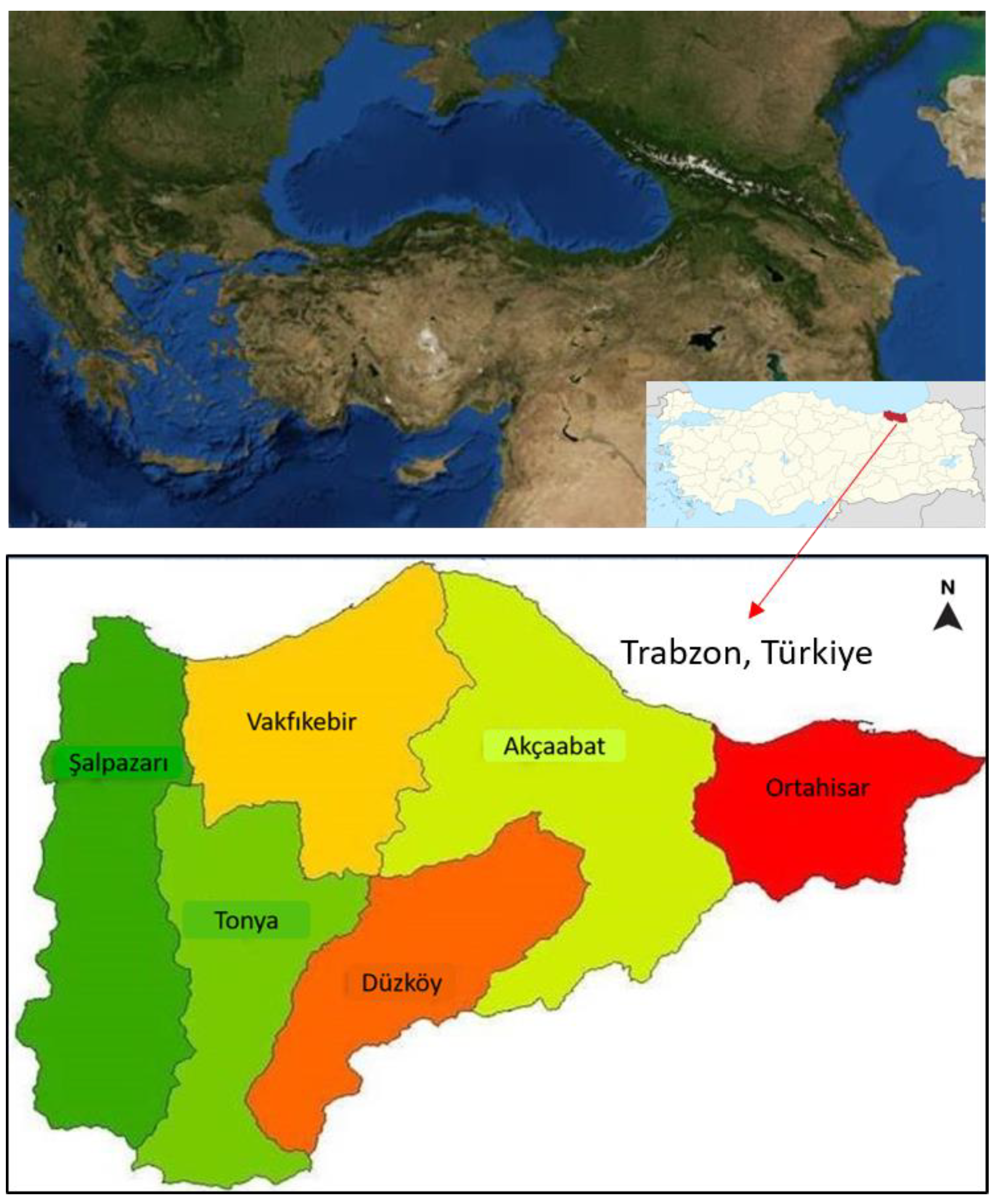
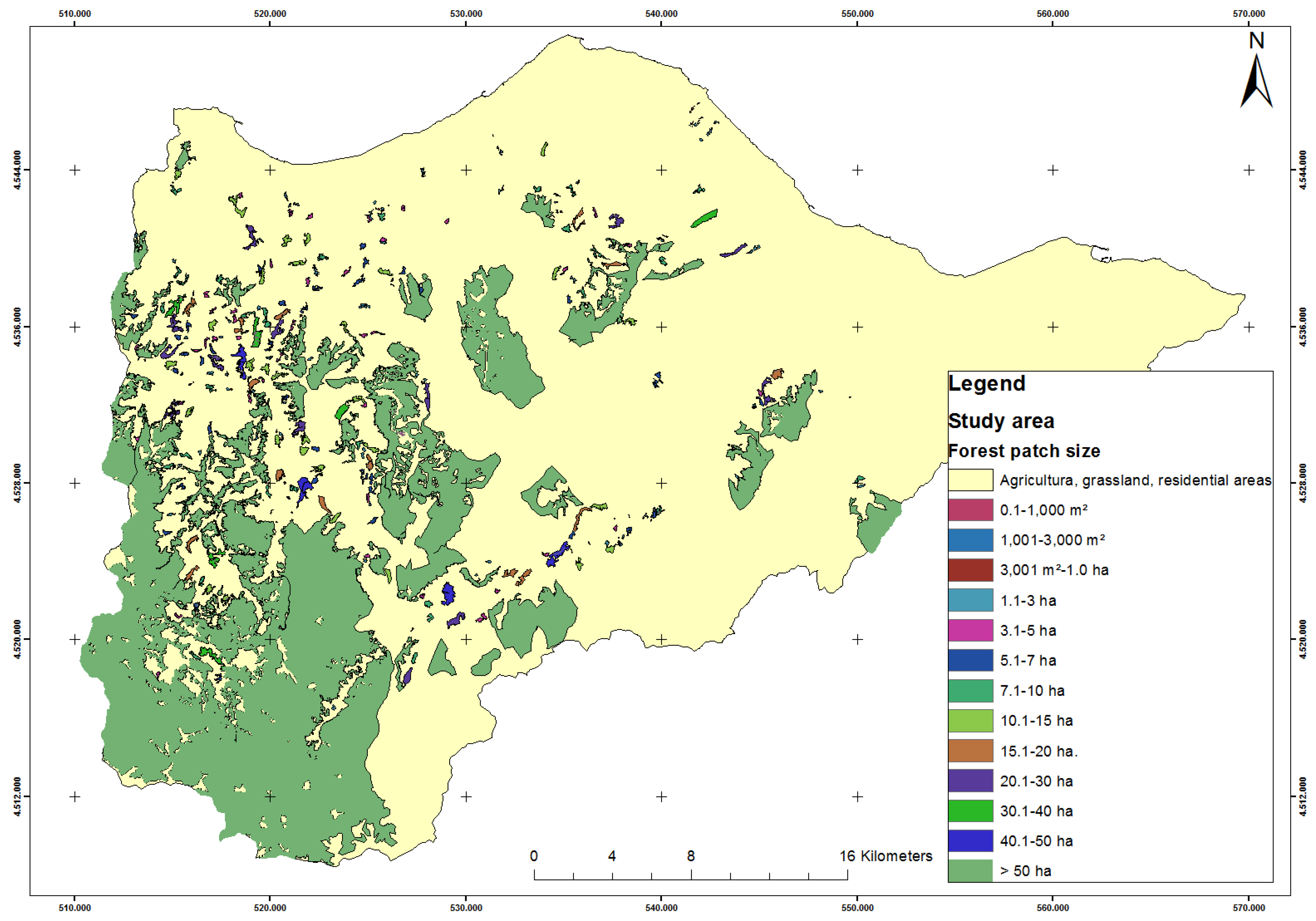
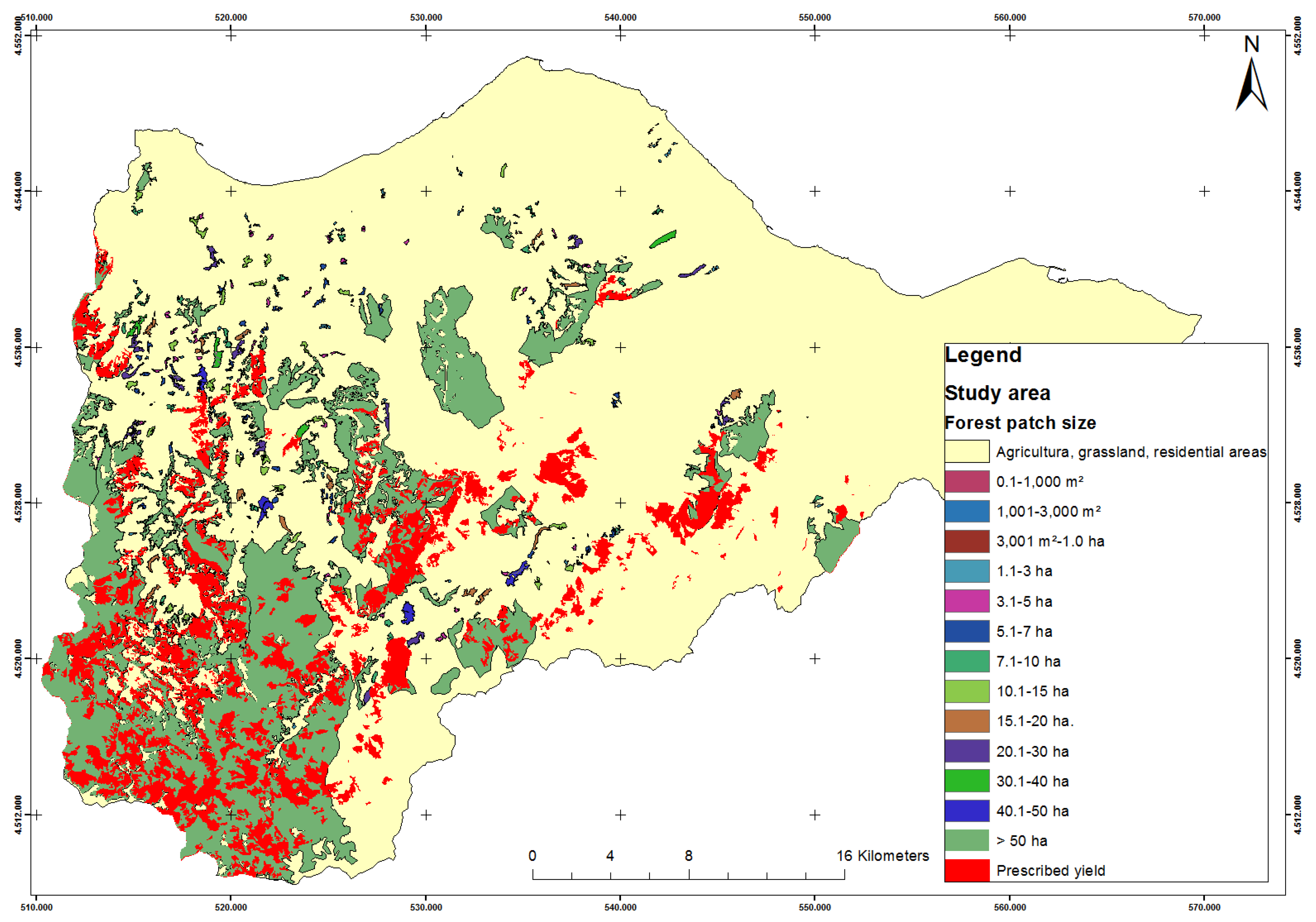
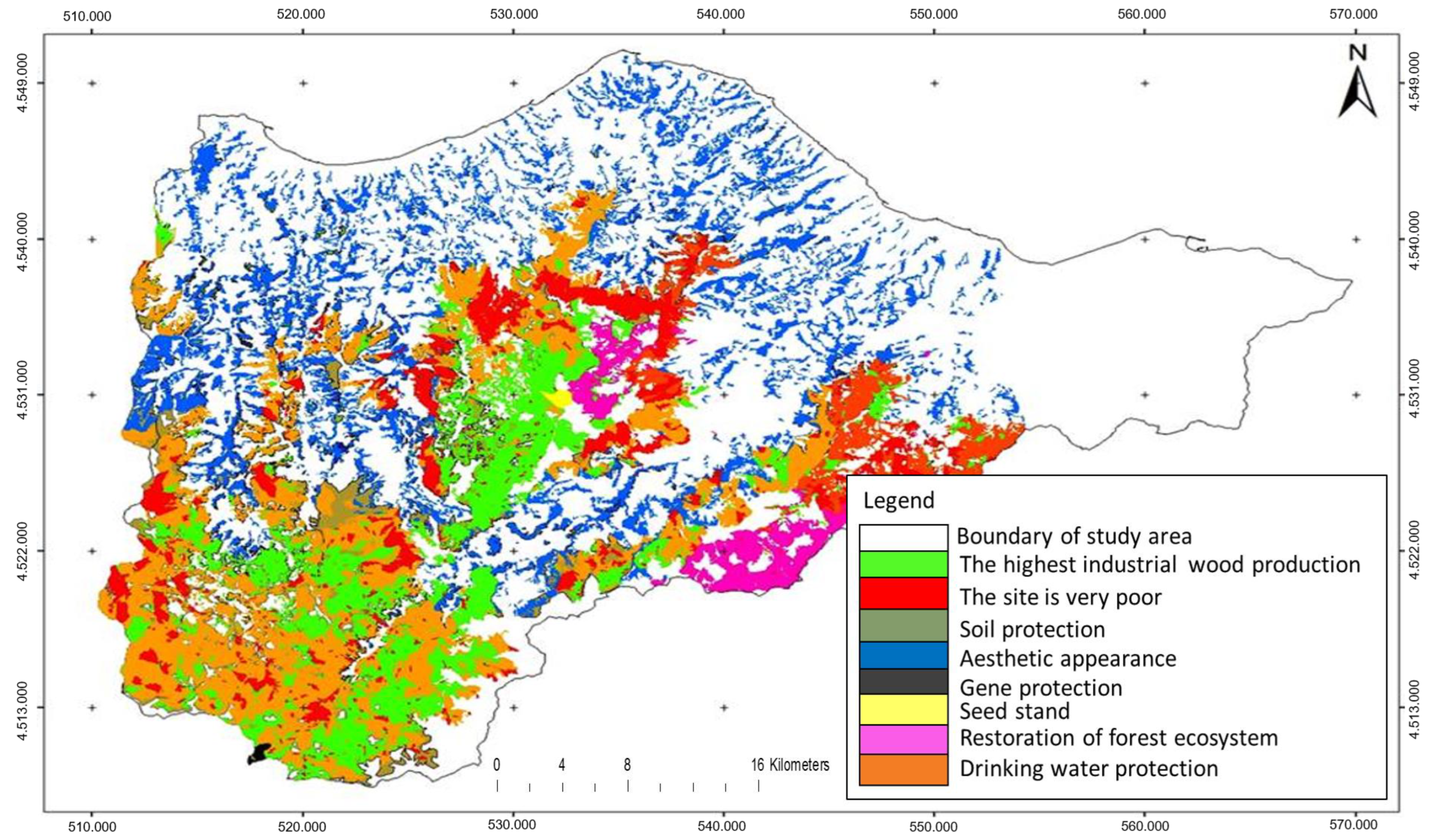
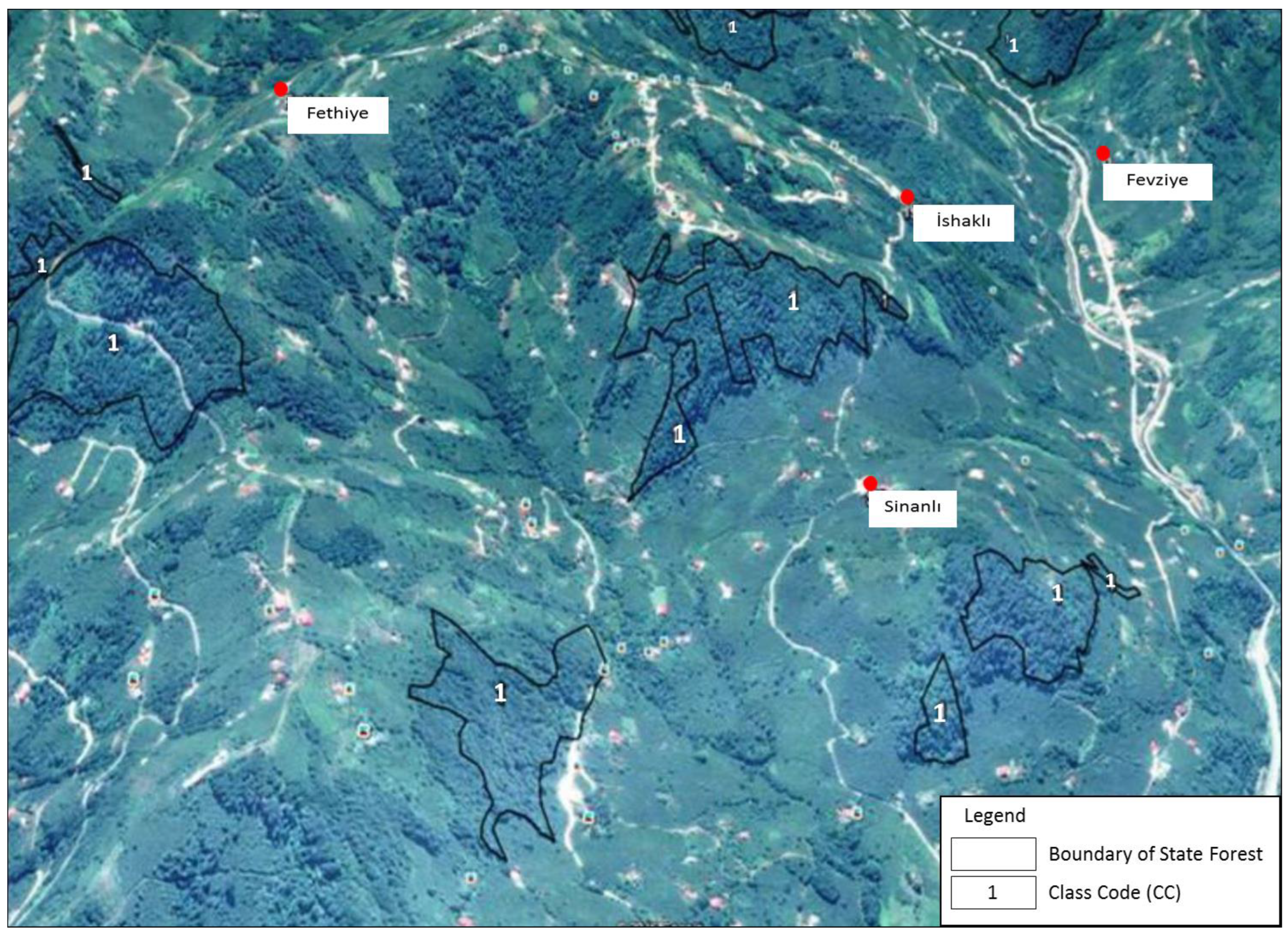
| The Spatial Land Metrics | Abbreviation | Definition [14,15] |
|---|---|---|
| Number of Patches | NP | Number of Patches is the number of patches of the corresponding patch type (class). |
| Class Area | CA | Class Area is the sum of the areas (m2) of all patches of the corresponding patch type, divided by 10,000 (to convert to hectares), which is the total class area. |
| Mean Patch Size | MPS | Mean Patch Size is the sum of the areas (m2) of all patches of the corresponding patch type, divided by the number of patches of the same type, divided by 10,000 (to convert to hectares). |
| Minimum Patch Area | MinPA | Minimum Patch Area |
| Maximum Patch Area | MaxPA | Maximum Patch Area |
| Mean Shape Index | MSI | Mean Shape Index is the sum of the patch perimeter (m) divided by the square root of patch area (m2) for each patch of the corresponding patch type, adjusted using a constant to adjust for a circular standard (vector) or square standard (raster), divided by the number of patches of the same type; in other words, MSI equals the average shape index (SHAPE) of patches of the corresponding patch type. |
| Area Weighted Mean Shape Index | AWMSI | Area Weighted Mean Shape Index is the average shape index (SHAPE) of patches of the corresponding patch type, weighted by patch area so that larger patches weigh more than smaller patches. |
| Mean Perimeter–Area Ratio | MPAR | Mean Perimeter–Area Ratio |
| Mean Patch Edge | MPE | Mean Patch Edge |
| Patch Size Coefficient of Variation | PSCoV | Patch Size Coefficient of Variation is the standard deviation in patch size (PSSD) divided by the mean patch size (MPS), multiplied by 100 (to convert to percent), which is the variability in patch size relative to the mean patch size. |
| Calculation Level | Calculation Parameters | ||||||||||
|---|---|---|---|---|---|---|---|---|---|---|---|
| Class | Class Code (CC) | Patch Number (NP) | CA (ha) | MPS (ha) | MinPA (ha) | MaxPA (ha) | MSI | AWMSI | MPAR | MPE | PSCoV |
| Level | |||||||||||
| Forest (ha) | 1 | 423 | 31,153.20 | 73.6 | 0.01 | 18,002 | 1.9 | 9.4 | 628 | 4621 | 1210.2 |
| Other land (ha) (agriculture, pasture, settlement, etc.) | 2 | 504 | 103,975.70 | 206.3 | 0.0013 | 101,137 | 1.8 | 13.7 | 1115 | 4156 | 2181.5 |
| Total landscape area (ha) | 135,128.90 | ||||||||||
| Size of Forest Fragment (m2-ha) | Number of Fragments | Number of Fragments (%) | Number of Fragments (Cumulative) | Number of Fragments (%) | Fragment Area (ha) | Fragment Area (%) | Fragment Area (ha) Cumulative | Fragment Area (%) Cumulative |
|---|---|---|---|---|---|---|---|---|
| 0.1–1000 m2 | 34 | 8 | 34 | 8 | 1.8 | 0.01 | 1.8 | 0.01 |
| 1001–3000 m2 | 34 | 8 | 68 | 16 | 7.1 | 0.02 | 8.9 | 0.03 |
| 3001 m2–1.0 ha | 68 | 16 | 136 | 32 | 38.5 | 0.12 | 47.4 | 0.15 |
| 1.1–3.0 | 75 | 18 | 211 | 50 | 140.0 | 0.45 | 187.4 | 0.60 |
| 3.1–5.0 | 43 | 10 | 254 | 60 | 171.9 | 0.55 | 359.3 | 1.15 |
| 5.1–7.0 | 36 | 9 | 290 | 69 | 215.8 | 0,69 | 575.1 | 1.84 |
| 7.1–10.0 | 30 | 7 | 320 | 76 | 246.7 | 0.79 | 821.8 | 2.63 |
| 10.1–15.0 | 31 | 7 | 351 | 83 | 376.3 | 1.21 | 1198.10 | 3.84 |
| 15.1–20.0 | 15 | 4 | 366 | 87 | 254.0 | 0.82 | 1452.10 | 4.66 |
| 20.1–30.0 | 13 | 3 | 379 | 90 | 308.8 | 0.99 | 1760.90 | 5.65 |
| 30.1–40.0 | 6 | 1 | 385 | 91 | 210.0 | 0.67 | 1970.90 | 6.32 |
| 40.1–50.0 | 4 | 1 | 389 | 92 | 188.9 | 0.61 | 2159.80 | 6.93 |
| ≥50.1 | 34 | 8 | 423 | 100 | 28,993,4 | 93.07 | 31,153.2 | 100 |
| No | Fragment Size Range | Number | No of F./Rate | Area | Area of F./Rate |
|---|---|---|---|---|---|
| (%) | (ha) | (%) | |||
| 1 | Forest Fragment ≤ 10 ha | 320 | 76 | 822 | 3 |
| 2 | 10 ha < Forest Fragment ≤ 99 ha | 82 | 19 | 2275.2 | 7 |
| 3 | Forest Fragment > 99 ha | 21 | 5 | 28,056 | 90 |
| Implementation | Average Annual EBM (Planned) (m3) | Average Realization (m3) | Rate (%) |
|---|---|---|---|
| Maintenance | 16,737 | 4650 | 28 |
| Regeneration | 5538 | 6978 | 126 |
| Total | 22,275 | 11,628 | 52 |
Disclaimer/Publisher’s Note: The statements, opinions and data contained in all publications are solely those of the individual author(s) and contributor(s) and not of MDPI and/or the editor(s). MDPI and/or the editor(s) disclaim responsibility for any injury to people or property resulting from any ideas, methods, instructions or products referred to in the content. |
© 2023 by the author. Licensee MDPI, Basel, Switzerland. This article is an open access article distributed under the terms and conditions of the Creative Commons Attribution (CC BY) license (https://creativecommons.org/licenses/by/4.0/).
Share and Cite
Diktaş Bulut, N. Human-Induced Forest Fragmentation in Trabzon, Eastern Black Sea Region, Türkiye: A Case Study. Forests 2023, 14, 1622. https://doi.org/10.3390/f14081622
Diktaş Bulut N. Human-Induced Forest Fragmentation in Trabzon, Eastern Black Sea Region, Türkiye: A Case Study. Forests. 2023; 14(8):1622. https://doi.org/10.3390/f14081622
Chicago/Turabian StyleDiktaş Bulut, Nur. 2023. "Human-Induced Forest Fragmentation in Trabzon, Eastern Black Sea Region, Türkiye: A Case Study" Forests 14, no. 8: 1622. https://doi.org/10.3390/f14081622
APA StyleDiktaş Bulut, N. (2023). Human-Induced Forest Fragmentation in Trabzon, Eastern Black Sea Region, Türkiye: A Case Study. Forests, 14(8), 1622. https://doi.org/10.3390/f14081622






